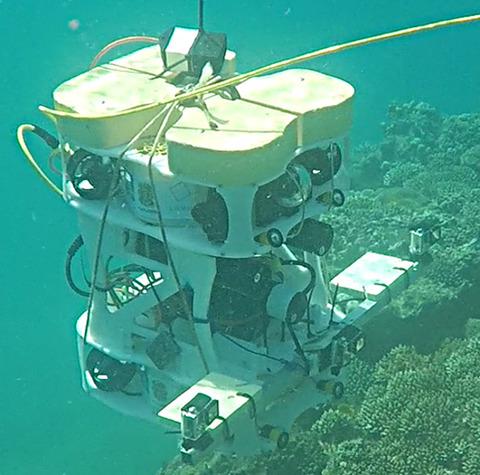当前位置:
X-MOL 学术
›
Remote Sens. Ecol. Conserv.
›
论文详情
Our official English website, www.x-mol.net, welcomes your
feedback! (Note: you will need to create a separate account there.)
Underwater robots provide similar fish biodiversity assessments as divers on coral reefs
Remote Sensing in Ecology and Conservation ( IF 3.9 ) Pub Date : 2021-06-05 , DOI: 10.1002/rse2.209 Mathilde Maslin 1 , Silvain Louis 2 , Karen Godary Dejean 3 , Lionel Lapierre 3 , Sébastien Villéger 4 , Thomas Claverie 4, 5
Remote Sensing in Ecology and Conservation ( IF 3.9 ) Pub Date : 2021-06-05 , DOI: 10.1002/rse2.209 Mathilde Maslin 1 , Silvain Louis 2 , Karen Godary Dejean 3 , Lionel Lapierre 3 , Sébastien Villéger 4 , Thomas Claverie 4, 5
Affiliation

|
Coral reefs are under increasing threat, and the loss of reef-associated fishes providing valuable ecosystem services is accelerating. The monitoring of such rapid changes has become a challenge for ecologists and ecosystems managers using traditional approaches like scuba divers performing underwater visual censuses (UVC) or diver operated video recording (DOV). However, the use of small, low-cost robots could help tackle the challenge of such monitoring, provided that they perform at least as well as diver-based methods. To address this question, tropical fish assemblages from 13 fringing reefs around Mayotte Island (Indian Ocean) were monitored along 50 m-long transects using stereo videos recorded by a semi-autonomous underwater vehicle (SAUV) and by a scuba diver (Diver Operated stereo Video system, DOV). Differences between the methods were tested for complementary fish assemblage metrics (species richness, total biomass, total density, Shannon diversity and Pielou evenness) and for the number and size of nine targeted species. SAUV recorded on average 35% higher biomass than DOV which in turn recorded on average 12% higher species richness. Biomass differences were found to be due to SAUV monitoring larger fishes than DOV, a potential marker of human-related fish avoidance behaviour. This study demonstrates that SAUV provides accurate metrics of coral reef fish biodiversity compared to diver-based procedures. Given their ability to conduct video transects at high frequency, 100 m depth range and at a moderate cost, SAUV is a promising tool for monitoring fish assemblages in coral reef ecosystems.
中文翻译:

水下机器人提供与珊瑚礁潜水员类似的鱼类生物多样性评估
珊瑚礁正面临越来越大的威胁,提供宝贵生态系统服务的与珊瑚礁相关的鱼类正在加速减少。对于使用传统方法的生态学家和生态系统管理者来说,监测这种快速变化已成为一项挑战,例如水肺潜水员进行水下视觉普查 (UVC) 或潜水员操作视频记录 (DOV)。然而,使用小型、低成本的机器人可以帮助应对这种监测的挑战,前提是它们的性能至少与基于潜水员的方法一样好。为了解决这个问题,使用由半自主水下航行器 (SAUV) 和水肺潜水员 (Diver Operated stereo视频系统,DOV)。对互补鱼类组合指标(物种丰富度、总生物量、总密度、香农多样性和 Pielou 均匀度)以及九个目标物种的数量和大小进行了测试。SAUV 记录的生物量平均比 DOV 高 35%,而 DOV 的物种丰富度平均高 12%。发现生物量差异是由于 SAUV 监测的鱼类比 DOV 更大,DOV 是人类相关鱼类回避行为的潜在标志。这项研究表明,与基于潜水员的程序相比,SAUV 提供了准确的珊瑚礁鱼类生物多样性指标。鉴于它们能够以高频率、100 m 深度范围和适中的成本进行视频横断面,SAUV 是监测珊瑚礁生态系统中鱼类群落的有前途的工具。
更新日期:2021-06-05
中文翻译:

水下机器人提供与珊瑚礁潜水员类似的鱼类生物多样性评估
珊瑚礁正面临越来越大的威胁,提供宝贵生态系统服务的与珊瑚礁相关的鱼类正在加速减少。对于使用传统方法的生态学家和生态系统管理者来说,监测这种快速变化已成为一项挑战,例如水肺潜水员进行水下视觉普查 (UVC) 或潜水员操作视频记录 (DOV)。然而,使用小型、低成本的机器人可以帮助应对这种监测的挑战,前提是它们的性能至少与基于潜水员的方法一样好。为了解决这个问题,使用由半自主水下航行器 (SAUV) 和水肺潜水员 (Diver Operated stereo视频系统,DOV)。对互补鱼类组合指标(物种丰富度、总生物量、总密度、香农多样性和 Pielou 均匀度)以及九个目标物种的数量和大小进行了测试。SAUV 记录的生物量平均比 DOV 高 35%,而 DOV 的物种丰富度平均高 12%。发现生物量差异是由于 SAUV 监测的鱼类比 DOV 更大,DOV 是人类相关鱼类回避行为的潜在标志。这项研究表明,与基于潜水员的程序相比,SAUV 提供了准确的珊瑚礁鱼类生物多样性指标。鉴于它们能够以高频率、100 m 深度范围和适中的成本进行视频横断面,SAUV 是监测珊瑚礁生态系统中鱼类群落的有前途的工具。











































 京公网安备 11010802027423号
京公网安备 11010802027423号